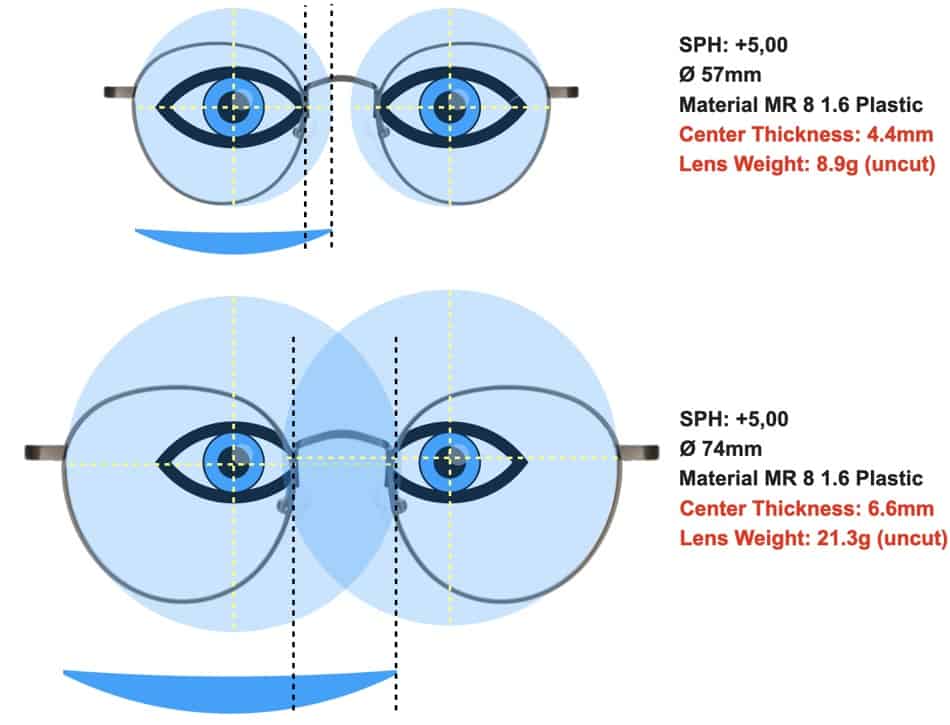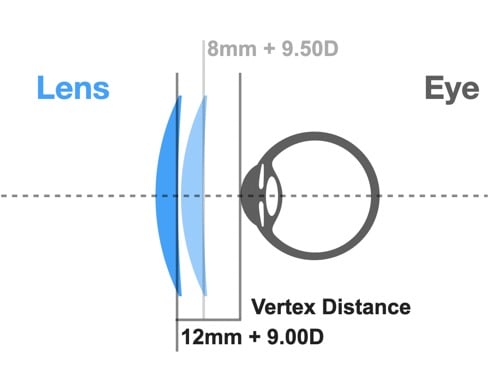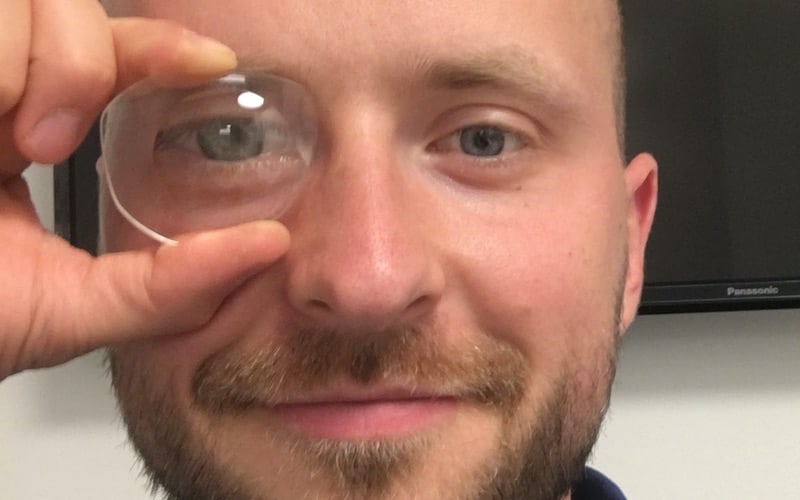Glasses for hyperopes can make your eyes look bigger. Here in this article, you will get the information about how you could optimize your glasses to get a more natural look.
The magnification is the result of your needed lens power in combination with prismatic effects. A few parameters influence how big your eyes look. Those parameters are:
- Lens thickness
- Lens power
- Distance between your eye and the lens back surface (vertex distance)
- Lens design
- Lens material
In most cases people notice their eyes look bigger with plus lenses if lens power is higher than 3 diopters. The higher the lens power is the bigger the eyes usually appear.
Of course, you just need a certain amount of lens power to be corrected optimally. This is nothing you can do much about. But you can influence the lens thickness with the frame you choose. If you choose to have a really big frame bigger lenses need to be fitted in. In such a case those bigger lenses will come with an increased thickness.

In the picture, you can see the correlation between lens thickness and the size of the different diameters of your lenses. But of course, the lens thickness is just one parameter. So let us dive deeper into this topic.
Oftentimes people only mention the magnified eyes. But what also appears to be bigger than in reality is the head. In a lot of cases if the frame is chosen to big you can see the peripheral part of the face magnified as well.
In a lot of cases, I would rather go with a slightly smaller frame compared to a frame that is more on the bigger side. Usually, the face and the eyes will end up looking a lot more natural and less magnified.
What Else to Look for Why Your Eyes Look Bigger With Your Glasses?
Here in the picture down below you can see an illustration of how the distance between your eyes and the lens back surface influences the lens.
If you had a close look at the illustration you will notice with different distances come with different lens powers to achieve the same result. To produce an optimal clear image those changes are necessary. So with very high lens powers like over +9 you should have in mind (or your optician) that your prescription needs to be fine-tuned if the distance between your eyes and the lens gets changed.

Even though the prescription might be a little higher with a lens sitting closer in front of your eye the magnification of your eye will be less dominant. Especially for higher hyperopes, the visual experience can change a lot with the lens design you buy. And this brings us to the next point which also influences the magnification of your glasses.
The Lens Designs to Reduce the Magnification Effect
Aspheric and atoric lens designs can influence the way how big your eyes look with your glasses. I want to get one thing clear here. The magnifying effect will not go away with those special lens designs. It just gets a little better.
Those lens designs lead to a change in the shape of the lenses and flattens them in the periphery. Not only will you have a bigger clear field of view but you will have a flatter and lighter lenses.
This of course is already a good thing with the things in mind we discussed earlier. But if you go all out with the optimizations in combination with a double aspheric design in most cases people really enjoy how your eyes look in regards to the size.

In some cases, wearers of those lenses do not like the visual experience. Even if everything is in place. In such a case an insider tip is double aspheric lenses from Seiko Vision. Because they have a lens design with a spherical component of 10mm which sits right in front of your eye.
This way you get the great flat thinner lenses and a visual experience you like even if you are not a fan of aspheric lens designs.
What Lens Material to Choose for Less Magnification?
Here in the table below you will see how the lens thickness will be influenced by the lens material. Before we spoke about the diameter (the size of the lens) and the lens design to bring the thickness down to reduce the magnification. But now you have all three components.
Therefore I made a table to give you a little more information in correlation to three different lens powers. Here below you can see calculations for a hyperope with 4.5, 6.5, and on the right 8 diopters.
On the left you can see the different materials.
| Material (Refractive Index) | Center Thickness (Diameter 63mm, SPH 4.5D) | Center Thickness (Diameter 63mm, SPH 6.5D) | Center Thickness (Diameter 63mm, SPH 8.0D) |
| 1.5 | 5.3mm | 7.3mm | 8.7mm |
| Poly | 4,7mm | 6.4mm | 7.6mm |
| MR 8 1.6 | 4.7mm | 6.3mm | 7.6mm |
| MR 10 1.67 | 4.3mm | 5.8mm | 6.9mm |
| MR 174 1.74 | 4.0mm | 5.3mm | 6.3mm |
What to Focus First on to Reduce Bigger Eyes With Your Glasses?
Go for a frame that fits optimal first. The more your prescription tends to be on the higher side choose slightly smaller frames with a small vertex distance. Of course, all the other information I gave you improves your looks too. But if the foundation is not right the rest of the optimization will not work as good.
In terms of the grinding process there is also one thing to mention. The lenses hold in the frame with a facet ground on the lens edge. If this facet is placed rather on the front compared to the middle the back lens surface will come back a millimeter more or so. Depending on how thick your lenses will be.

This helps a little to place the lens a little closer to your eye and it makes the lenses fit in the frame a little more aesthetically pleasing.
I wish you a great day.
